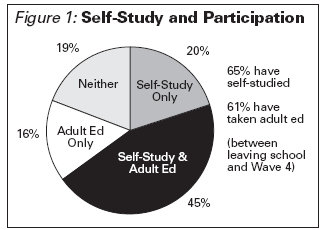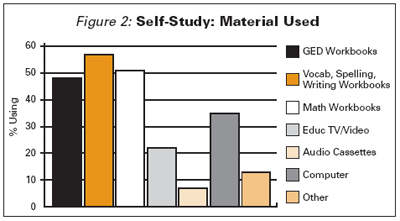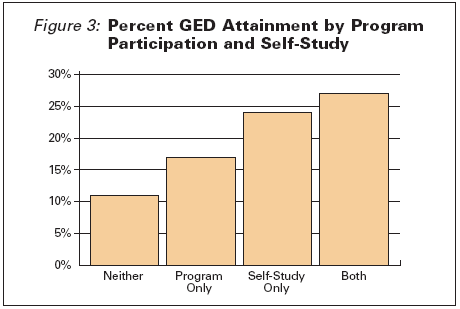This page is located at: http://www.ncsall.net/?id=1152
Self-Study: Broadening the Concepts of Participation and Program Support
by Stephen Reder & Clare Strawn
Self-study can be defined as working on one's own to improve reading, writing, or math skills or to prepare for the tests of General Educational Development (GED). We now know that it is a widespread mode of basic skills development among adults who did not complete high school. Self-study occurs widely among participants in adult basic education (ABE) programs as well as among high school non-completers who do not participate in ABE. In 1998, when the National Center for the Study of Adult Learning and Literacy (NCSALL) launched its Longitudinal Study of Adult Learning (LSAL), the prevalence of self-study among those without a high school diploma may have been suspected but was not well documented.
The LSAL sample started with 940 high school non-completers from metropolitan Portland, Oregon, who ranged in age from 18 to 44 years old and did not have GED credentials in 1997; about 93 percent remain in the study. Five waves of data were collected over the course of seven years. Early data indicated that of those in the study who had participated in a formal ABE class prior to 1998, nearly half (46 percent) had also engaged in self-study to improve their reading, writing, or math skills or to prepare for the GED. Among those in the population who had never participated in an ABE program, one in three (34 percent) had engaged in self-directed efforts to improve their basic skills. The prevalence of self-study we were seeing broadened our view of how adults create literacy learning opportunities for them selves. To understand better the implications of our initial findings, we added questions about self-directed efforts to the study. In this article we share several new findings that deepen our under standing of self-study and its implications for the field of adult basic education.
Part of a Continuum
The LSAL research indicates that self-study should be viewed as being on a continuum with, rather than an alternative to, classroom-based instruction. Most adults who have tried in one way or another to improve their basic skills or prepare for the GED have tried both self-study and participating in a course. By the time we collected the fourth wave of data, nearly two-thirds (65 percent) of the adults in the study had engaged in self-study since leaving high school. Self-study and program participation appear to be complementary approaches. Some individuals use only one of the two approaches, many use both, and some use neither. The largest group within the study population used both approaches.
Figure 1 shows the percentages, cumulative through the fourth wave of data, of the population in four exhaustive, mutually exclusive categories of participation: individuals who neither engaged in self-study nor attended a program (19 percent); individuals who attended a program but never engaged in self-study (16 percent); individuals who engaged in self-study but never attended a program (20 percent); and individuals who both engaged in self-study and attended a program (45 percent). When we look closely at the temporal patterns among those who used both approaches, we see examples of individuals who began with a period of self-study and later attended a program, as well as individuals who attended a program and later engaged in a period of self-study. These patterns are consistent with the notion of active learners who use both approaches as resources to support learning, using each as it fits life circumstances or needs for assistance.

Furthermore, the majority of the LSAL population who participated in programs, when asked to describe them, reported that the programs included a substantial amount of individual work in non-classroom settings as well as direct instruction in larger groups or classroom settings. Many of the local ABE and GED programs serving the LSAL population include learning centers or computer labs where learners work individually, supplemented by on-demand instructional assistance. In some respects, existing program practices already include activities similar to facilitated self-study.
Self-Study for What?
Individuals who engaged in self-study were asked whether their self-study was intended to prepare for the GED; improve their reading, writing, or math skills; or both prepare for the GED and improve their skills. About one in four (24 percent) of those who engaged in self-study indicated they did so only to prepare for the GED; nearly one half (45 percent) indicated they engaged in self-study to improve their skills (but not to prepare for the GED); and nearly one in three (30 percent) indicated that they engaged in self-study to improve their skills and prepare for the GED. Thus more than one half (54 percent) of those who engaged in self-study did so (at least in part) to prepare for the GED.
We asked individuals who indicated their self-study was, at least in part, to prepare for the GED about the topics for which they were preparing. Since obtaining a GED requires passing five individual tests, it is not surprising that the majority of those engaging in self-study to prepare for the GED focused on the test topics. Almost everyone focused on math, although more than three quarters also focused on writing and language arts.
Skill Levels Vary
Adults with relatively weak basic skills were just as likely to engage in self-study as those with higher levels of proficiency. In fact, as literacy proficiencies rise, adults in the LSAL sample became less likely to engage in self-study to improve their basic skills. About one half of the adults assessed at the lowest proficiency level had engaged in self-study, with progressively declining proportions as assessed skill levels increased. At relatively high levels of proficiency, of course, one might expect adults' felt needs for improved basic skills to diminish, lowering their tendency to self-study to improve those skills. The fact that a substantial proportion (more than 30 percent) of adults at even the highest levels of proficiency engaged in self-study indicates that adults seek to improve their basic skills even beyond the levels needed to pass the GED tests.
Self-Study with What?
Figure 2 exhibits the frequency that various types of materials were used in self-study activities. The most common types were workbooks designed specifically for GED preparation and workbooks designed to help individuals improve their math skills or their vocabulary, spelling, or writing. More than one third (35 per cent) reported using computer-based materials for self-study when asked in the third wave of data collection in 2000-2001. The rapid increase in the use of computer technologies that we observed in the LSAL population over the four subsequent years suggests that the computer will quickly become the medium of choice for self-study as well.

GED Received?
Figure 3 shows that only 10 per cent of individuals who neither participated in a program nor engaged in self-study received a GED. Many in this "Neither" group had no intention of obtaining a GED, but those in the Neither group who received a GED were among the sizable number of GED test takers who report not preparing at all for the tests (Baldwin et al., 1995). About 17 percent of those who participated in a basic skills program but did not self-study received their GED, comparable with 24 percent of those who engaged in self-study but did not participate in a program. The highest percentage of GED attainment (27 percent) was observed among those who did both.

These data seem to indicate that both program participation and self-study, whether occurring alone or in combination, are associated with GED attainment. This is of course what we expect to see for program participation, since GED attainment has been the historical mission of adult education programs. Perhaps less expected is the association between self-study and GED attainment, a relationship that appears at least as strong as that between program participation and GED attainment.
A similar pattern of outcomes can be seen in adults' own perceptions of their skill development. Starting with the second wave of data, in each wave we asked individuals about changes in their reading, writing, and math skills since the preceding wave. For each skill domain, respondents reported changes in their frequency of using the skill in daily life, in using the skill in new ways, and in changes in their overall skill level. For each skill area, the same ordering of improvement appeared across the four participation subpopulations that we saw for GED attainment in Figure 3. The least change was reported by the subpopulation that neither went to programs nor engaged in self-study, the most change by the people who did both, with intermediate levels of change in the groups that used only one of the two approaches.
We should be careful interpreting these differences in GED attainment percentages or measures of skill development among these participation groups. Individuals self-select them selves into the four participation groups and the four subpopulations may thus be quite different, so that differences in outcome measures may not directly reflect the differential effectiveness of various modes of participation. Additional modeling and analyses are underway to clarify the interpretation of these data.
Implications for Program and Policy
If adult literacy programs are thought of as supporting self-study as well as providing classes, adult literacy programs could serve more learners (since many adults self-study who never come to formal classes), attract new learners to classes (since some adults who self-study might later attend classes), and increase the overall persistence of adult literacy learning (since many adult literacy learners engage in self-study and attend classes at different points in time).
Recognizing self-study as a legitimate aspect of adult literacy demands a broader conception of the adult literacy learner. This is a learner who chooses among a range of literacy development strategies and resources, including self-study, attending classes, working with a tutor or mentor, and so forth (Wikelund et al.,1992). Differences among learners' preferred modes of learning, life circumstances, and accessibility of learning resources shape their choices about how to pursue literacy development. Over time, as learners' needs and goals, life situations, and understandings of learning resources change, the literacy learning strategies and resources used may change as well (see, for example, Beder, 1991; Belzer, 1998).
To support this expanded notion of the adult literacy learner, programs need to expand their services to support learning for adults engaged in self-study activities. Such expansion may require changes in policy and program design. Policy changes at the federal, state, or local levels may be needed so that programs can utilize adult education funds to support self-study. Issues may need to be resolved about the eligibility of self-study learners for official enrollment counts, about assessing their skills and progress, and about other aspects of accountability required by various categories of federal and state funds. In many respects, these policy and administrative issues may be similar to those already being addressed by some programs for students engaged in various forms of distance rather than on-site learning activities.
New program designs are needed to facilitate and support the learning of adults engaged in self-study and to link self-study activities with program services. Learners engaged in self-study may benefit from assistance with identifying learning goals, skill assessment, selection of study materials (whether print-based, online, or multimedia), mentoring or tutoring, progress assessment, and so forth. Not all such support materials and services need to be newly developed; many usable materials and services may exist and others could be used in facilitating self-study. LSAL has identified a range of materials in terms of content and media already being used by adults engaged in self-study. Frequently mentioned examples included study guides for the individual GED tests, skill workbooks, and GED practice tests.
Other types of adult literacy services could also be included as learning support resources. On-demand tutoring or mentoring, for example, could effectively be provided to some learners engaged in self-study at home. Homework hotlines, one of which is described briefly in the article, The GED Via TV, in which students working at home call in for assistance, may be useful. Many community-based organizations — both those that provide adult literacy programs and those that do not — offer a range of services, social net works, and contexts essential for engaging, motivating and supporting adult learning. Two examples of programs that support self-study are featured in other articles in this issue, by Schoneck and Robertson. A broader model for facilitated self-study, the Learner Web, will be piloted and evaluated in selected sites across the country (see the box, below).
In Conclusion
The LSAL has introduced self-study into the national conversation about ABE. With funding from the National Institute for Literacy, a sixth wave of data will be collected. Once the data are completely analyzed, other variables such as age, gender, and whether individuals had the goals of obtaining a GED or improving their basic skills can be considered in more systematic interpretations. Future analyses and publications will explore how self-study and program participation affect the growth of literacy proficiencies and everyday literacy practices across the adult lifespan. More research needs to be done to understand how effective self-study is carried out and can be supported. In the meantime, teachers and programs can query their students to find out whether they study on their own, and to encourage them to do so. Teachers can find out what kinds of support learners need to self-study, and experiment with providing it. Programs can share their results on the Focus on Basics discussion list, so all can benefit as we broaden our concepts of programs and participation.
References
Baldwin, J., Kirsch, I. S., Rock, D., & Yamamoto, K. (1995). The Literacy Proficiencies of GED Examinees: Results from the GED-NALS Comparison Study. Washington, DC & Princeton, NJ: American Council on Education & Educational Testing Service.
Beder, H. (1991). Adult literacy: Issues for Policy and Practice. Malabar, FL: Krieger Publishing Company.
Belzer, A. (1998). "Stopping out, not dropping out." Focus on Basics, 2(A), 15-17.
Reder, S. & Strawn, C. (2001a). " The K-12 school experiences of high school dropouts." Focus on Basics, 4(D), 12-13.
Reder, S. & Strawn, C. (2001b). "Program participation and self-directed learning to improve basic skills." Focus on Basics, 4(D), 14-17.
Wikelund, K., Reder, S., & Hart-Landsberg, S. (1992). Expanding Theories of Adult Literacy Participation: A Literature Review (NCAL Technical Report TR 92-1). Philadelphia: National Center on Adult Literacy, University of Pennsylvania.
About the Authors
Stephen Reder is University Professor and Chair of the Department of Applied Linguistics at Portland State University, Portland, Oregon. His research interests focus on adult literacy and second language development. He is the Principal Investigator of two NCSALL projects: the Adult ESOL Labsite project and the Longitudinal Study of Adult Learning.
Clare Strawn is Assistant Professor at Portland State University, Portland, Oregon, and has worked on the Longitudinal Study of Adult Learning since 1997. She is interested in the intersection of learning and community development, social capital influences on learning strategies, and technology.
The LSAL
The LSAL was designed as a panel study, representative of a local (rather than a national) target population for adult literacy education. This target population was defined as residents of the Portland, Oregon, metropolitan area ranging in age from 18 to 44 years old, proficient but not necessarily native English speakers, high school dropouts (i.e., did not receive a high school diploma and were no longer enrolled in school) who had not received a GED or other high school equivalency credential. The LSAL sample contained 940 individuals and was weighted so that population statistics could be estimated from the sample data. A series of five interviews and skills assessments — called "waves" — were conducted with each respondent over a period of seven years. Data from Waves 1 to 4 have been analyzed and are discussed in this article. About 93 percent of the original sample has been retained through Wave 4. More information available |
The Learner WebThe Learner Web (LW) is a Web- and telephone-accessed application that provides customized, guided instructional support to adults seeking to improve their basic skills, prepare for the GED, or pursue other learning goals such as citizenship, family literacy, or college prep. The LW makes resources accessible to learners on their own time and in their own environment. A learner’s goals and skill needs are matched to supportive resources available online or offline in the local community. Learners can also be connected with volunteer tutors. The LW is designed to support and enhance, not replace, existing educational programs and resources in the community. By better connecting adults’ self-study activities with programs and other resources in their communities, the LW will extend the reach and enhance the impact of learning already taking place. Using its database, the LW generates a customized list of resources and tools that match a learner’s goal, needs, skill level and step of a plan (e.g., online resources for improving basic math skills in preparation for taking the GED Math Test). Adults may find the LW directly on the Internet or be referred to it by local organizations. Individuals can easily create their own logins, using screen names if anonymity is desired. A ZIP code is used to identify appropriate local resources. Distance education systems, Web sites, print materials, and other supports are entries (called Resources) in the LW database that are matched to adults’ individual goals, needs, skills and plans. In this way, the LW connects with and leverages other programs and resources. It connects learners with tutors, helpers, and counselors either through the Internet, over the telephone, or face-to-face in their local communities, depending on the preferences of learners and local partnering organizations. An online learner history and work portfolio can be shared by and help coordinate the efforts of the various assistants who work with a given learner. |
